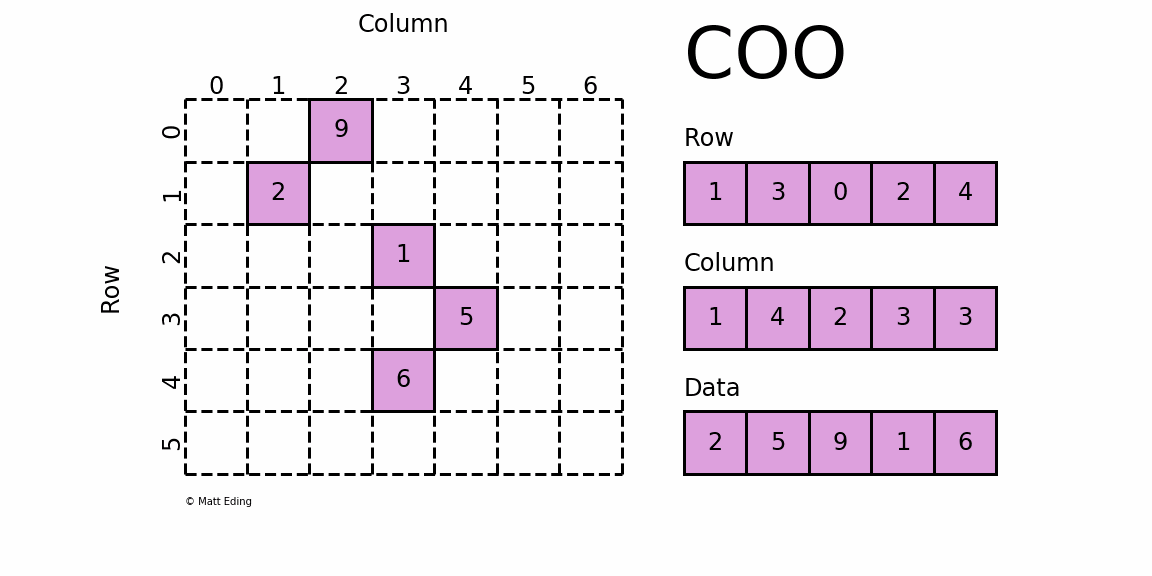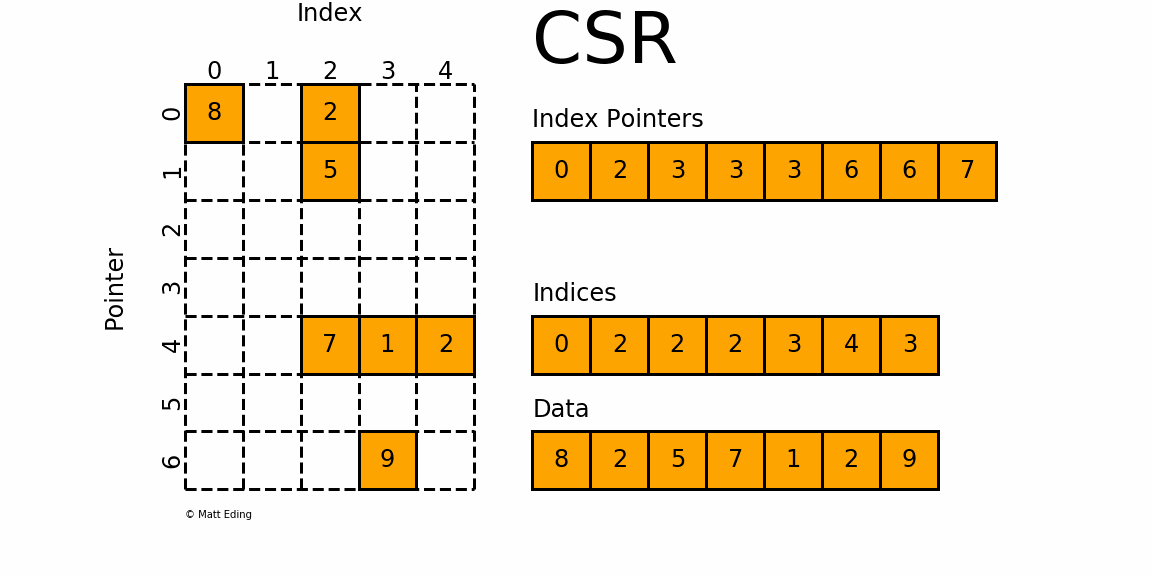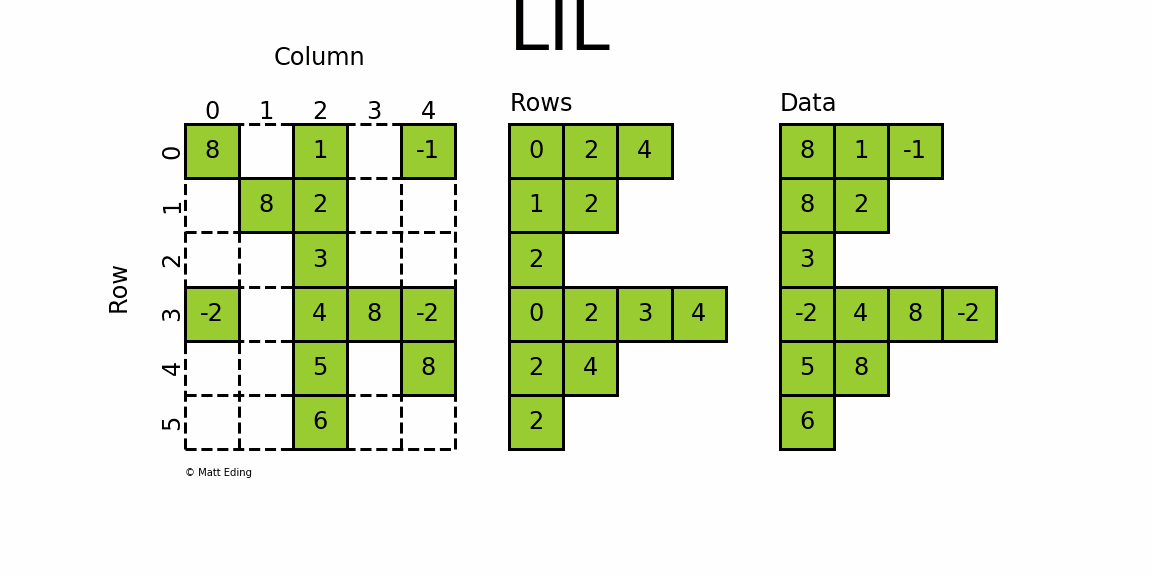1.背景
在数据科学和深度学习等领域常会采用矩阵格式来存储数据,但当矩阵较为庞大且非零元素较少时, 如果依然使用dense的矩阵进行存储和计算将是极其低效且耗费资源的。所以,通常我们采用Sparse稀疏矩阵的方式来存储矩阵,提高存储和运算效率。下面将对SciPy中七种常见的存储方式(COO/ CSR/ CSC/ BSR/ DOK/ LIL/ DIA)的概念和用法进行介绍和对比总结。
2.稀疏矩阵简介
2.1 稀疏矩阵
- 稀疏矩阵
- 在数值分析中,是其元素大部分为零的矩阵。
- 在矩阵中,若数值0的元素数目远多于非0元素的数目,并且非0元素分布没有规律
- 非零元素的总数比上矩阵所有元素的总数。
2.2 压缩存储
存储矩阵的一般方法是采用二维数组,其优点是可以随机地访问每一个元素,因而能够容易实现矩阵的各种运算, 如转置运算、加法运算、乘法运算等。
对于稀疏矩阵,它通常具有很大的维度,有时甚大到整个矩阵(零元素)占用了绝大部分内存。
采用二维数组的存储方法既浪费大量的存储单元来存放零元素,又要在运算中浪费大量的时间来进行零元素的无效运算。因此必须考虑对稀疏矩阵进行压缩存储(只存储非零元素)。
from scipy import sparse
help(sparse)
'''
Sparse Matrix Storage Formats
There are seven available sparse matrix types:
1. csc_matrix: Compressed Sparse Column format
2. csr_matrix: Compressed Sparse Row format
3. bsr_matrix: Block Sparse Row format
4. lil_matrix: List of Lists format
5. dok_matrix: Dictionary of Keys format
6. coo_matrix: Coordinate format (aka IJV, triplet format)
7. dia_matrix: Diagonal format
8. spmatrix: Sparse matrix base clas
'''其中一般较为常用的是csc_matrix,csr_matrix和coo_matrix。
2.3 矩阵属性
from scipy.sparse import csr_matrix
### 共有属性
mat.shape # 矩阵形状
mat.dtype # 数据类型
mat.ndim # 矩阵维度
mat.nnz # 非零个数
mat.data # 非零值, 一维数组
### COO 特有的
coo.row # 矩阵行索引
coo.col # 矩阵列索引
### CSR\CSC\BSR 特有的
bsr.indices # 索引数组
bsr.indptr # 指针数组
bsr.has_sorted_indices # 索引是否排序
bsr.blocksize # BSR矩阵块大小2.4 通用方法
import scipy.sparse as sp
### 转换矩阵格式
tobsr()、tocsr()、to_csc()、to_dia()、to_dok()、to_lil()
mat.toarray() # 转为array
mat.todense() # 转为dense
# 返回给定格式的稀疏矩阵
mat.asformat(format)
# 返回给定元素格式的稀疏矩阵
mat.astype(t)
### 检查矩阵格式
issparse、isspmatrix_lil、isspmatrix_csc、isspmatrix_csr
sp.issparse(mat)
### 获取矩阵数据
mat.getcol(j) # 返回矩阵列j的一个拷贝,作为一个(mx 1) 稀疏矩阵 (列向量)
mat.getrow(i) # 返回矩阵行i的一个拷贝,作为一个(1 x n) 稀疏矩阵 (行向量)
mat.nonzero() # 非0元索引
mat.diagonal() # 返回矩阵主对角元素
mat.max([axis]) # 给定轴的矩阵最大元素
### 矩阵运算
mat += mat # 加
mat = mat * 5 # 乘
mat.dot(other) # 坐标点积
resize(self, *shape)
transpose(self[, axes, copy])3.稀疏矩阵的分类
3.1 COO-coo_matrix
3.1.1Coordinate Matrix 对角存储矩阵
定义详解
- 采用三元组(row, col, data)(或称为ijv format)的形式来存储矩阵中非零元素的信息 ;
- 三个数组 row 、col 和 data 分别保存非零元素的行下标、列下标与值(一般长度相同 );
- 故 coo[row[k]][col[k]] = data[k] ,即矩阵的第 row[k] 行、第 col[k] 列的值为 data[k]

- 当
row[0] = 1,column[0] = 1时,data[0] = 2,故coo[1][1] = 2- 当
row[3] = 0,column[3] = 2时,data[3] = 9,故coo[0][3] = 9
3.1.2 应用场景
- 主要用来创建矩阵,因为coo_matrix无法对矩阵的元素进行增删改等操作
- 一旦创建之后,除了将之转换成其它格式的矩阵,几乎无法对其做任何操作和矩阵运算
3.1.3 优缺点
优点:
- 转换成其它存储格式很快捷简便(
tobsr()、tocsr()、to_csc()、to_dia()、to_dok()、to_lil())- 能与CSR / CSC格式的快速转换
- 允许重复的索引(例如在1行1列处存了值2.0,又在1行1列处存了值3.0,则转换成其它矩阵时就是2.0+3.0=5.0)
缺点:
- 不支持切片和算术运算操作
- 如果稀疏矩阵仅包含非0元素的对角线,则对角存储格式(DIA)可以减少非0元素定位的信息量
- 这种存储格式对有限元素或者有限差分离散化的矩阵尤其有效
3.1.4 实例化
-
coo_matrix(D):D代表密集矩阵; -
coo_matrix(S):S代表其他类型稀疏矩阵; -
coo_matrix((M, N), [dtype]):构建一个shape为M*N的空矩阵,默认数据类型是d; coo_matrix((data, (i, j)), [shape=(M, N)])):三元组初始化
-
i[:]: 行索引 -
j[:]: 列索引 A[i[k], j[k]]=data[k]
4.1.5 特殊属性
-
data:稀疏矩阵存储的值,是一个一维数组 -
row:与data同等长度的一维数组,表征data中每个元素的行号 -
col:与data同等长度的一维数组,表征data中每个元素的列号
4.1.6 案例演示
# 数据
row = [0, 1, 2, 2]
col = [0, 1, 2, 3]
data = [1, 2, 3, 4]
# 生成coo格式的矩阵
# <class 'scipy.sparse.coo.coo_matrix'>
coo_mat = sparse.coo_matrix((data, (row, col)), shape=(4, 4), dtype=np.int)
# coordinate-value format
print(coo)
'''
(0, 0) 1
(1, 1) 2
(2, 2) 3
(3, 3) 4
'''
# 查看数据
coo.data
coo.row
coo.col
# 转化array
# <class 'numpy.ndarray'>
coo_mat.toarray()
'''
array([[1, 0, 0, 0],
[0, 2, 0, 0],
[0, 0, 3, 4],
[0, 0, 0, 0]])
'''3.2 CSR - csr_matrix
3.2.1 Compressed Sparse Row Matrix 压缩稀疏行格式
- csr_matrix是按行对矩阵进行压缩的;
- 通过
indices,indptr,data来确定矩阵。 -
data表示矩阵中的非零数据 - 对于第
i行而言,该行中非零元素的列索引为indices[indptr[i]:indptr[i+1]] - 可以将
indptr理解成利用其自身索引i来指向第i行元素的列索引 - 根据
[indptr[i]:indptr[i+1]],就得到该行中的非零元素个数,如
- 若
index[i] = 3且index[i+1] = 3,则第i行的没有非零元素 - 若
index[j] = 6且index[j+1] = 7,则第j行的非零元素的列索引为indices[6:7]
- 得到了行索引、列索引,相应的数据存放在:
data[indptr[i]:indptr[i+1]]

- 对于矩阵第0行,需要先得到其非零元素列索引
- 由
indptr[0] = 0和indptr[1] = 2可知,第0行有两个非零元素。 - 它们的列索引为
indices[0:2] = [0, 2],且存放的数据为data[0] = 8,data[1] = 2 - 因此矩阵第
0行的非零元素csr[0][0] = 8和csr[0][2] = 2
- 对于矩阵第4行,同样需要先计算其非零元素列索引
- 由
indptr[4] = 3和indptr[5] = 6可知,第4行有3个非零元素。 - 它们的列索引为
indices[3:6] = [2, 3,4],且存放的数据为data[3] = 7,data[4] = 1,data[5] = 2 - 因此矩阵第
4行的非零元素csr[4][2] = 7,csr[4][3] = 1和csr[4][4] = 2
3.2.2 适用场景
常用于读入数据后进行稀疏矩阵计算,运算高效
3.2.3 优缺点
优点:
- 高效的稀疏矩阵算术运算
- 高效的行切片
- 快速地矩阵矢量积运算
缺点:
- 较慢地列切片操作(可以考虑CSC)
- 转换到稀疏结构代价较高(可以考虑LIL,DOK)
3.2.4 实例化
-
csr_matrix(D):D代表密集矩阵; -
csr_matrix(S):S代表其他类型稀疏矩阵 -
csr_matrix((M, N), [dtype]):构建一个shape为M*N的空矩阵,默认数据类型是d, csr_matrix((data, (row_ind, col_ind)), [shape=(M, N)]))
- 三者关系:
a[row_ind[k], col_ind[k]] = data[k]
csr_matrix((data, indices, indptr), [shape=(M, N)])
- 第i行的列索引存储在其中
indices[indptr[i]:indptr[i+1]] - 其对应值存储在中
data[indptr[i]:indptr[i+1]]
3.2.5 特殊属性
-
data:稀疏矩阵存储的值,一维数组 -
indices:存储矩阵有有非零值的列索引 -
indptr:类似指向列索引的指针数组 -
[has_sorted_indices]: 索引indices是否排序
3.2.6 案例演示
# 生成数据
indptr = np.array([0, 2, 3, 3, 3, 6, 6, 7])
indices = np.array([0, 2, 2, 2, 3, 4, 3])
data = np.array([8, 2, 5, 7, 1, 2, 9])
# 创建矩阵
csr = sparse.csr_matrix((data, indices, indptr))
# 转为array
csr.toarray()
'''
array([[1, 0, 2],
[0, 0, 3],
[4, 5, 6]])
'''
# 按row行来压缩
# 对于第i行,非0数据列是indices[indptr[i]:indptr[i+1]] 数据是data[indptr[i]:indptr[i+1]]
# 在本例中
# 第0行,有非0的数据列是indices[indptr[0]:indptr[1]] = indices[0:2] = [0,2]
# 数据是data[indptr[0]:indptr[1]] = data[0:2] = [1,2],所以在第0行第0列是1,第2列是2
# 第1行,有非0的数据列是indices[indptr[1]:indptr[2]] = indices[2:3] = [2]
# 数据是data[indptr[1]:indptr[2] = data[2:3] = [3],所以在第1行第2列是3
# 第2行,有非0的数据列是indices[indptr[2]:indptr[3]] = indices[3:6] = [0,1,2]
# 数据是data[indptr[2]:indptr[3]] = data[3:6] = [4,5,6],所以在第2行第0列是4,第1列是5,第2列是63.3 CSC - csc_matrix
3.3.1 Compressed Sparse Column Matrix 压缩稀疏列矩阵
- csc_matrix是按列对矩阵进行压缩的
- 通过 indices, indptr,data 来确定矩阵,可以对比CSR
-
data表示矩阵中的非零数据 - 对于第
i列而言,该行中非零元素的行索引为indices[indptr[i]:indptr[i+1]] - 可以将
indptr理解成利用其自身索引i来指向第i列元素的列索引 - 根据
[indptr[i]:indptr[i+1]],我就得到了该行中的非零元素个数,如:
- 若
index[i] = 1且index[i+1] = 1,则第i列的没有非零元素 - 若
index[j] = 4且index[j+1] = 6,则第j列的非零元素的行索引为indices[4:6]
- 得到了列索引、行索引,相应的数据存放在:
data[indptr[i]:indptr[i+1]]

- 对于矩阵第0列,需要先得到其非零元素行索引
- 由
indptr[0] = 0和indptr[1] = 1可知,第0列行有1个非零元素。 - 它们的行索引为
indices[0:1] = [0],且存放的数据为data[0] = 8 - 因此矩阵第
0行的非零元素csc[0][0] = 8
- 对于矩阵第3列,同样需要先计算其非零元素行索引
- 由
indptr[3] = 4和indptr[4] = 6可知,第4行有2个非零元素。 - 它们的行索引为
indices[4:6] = [4, 6],且存放的数据为data[4] = 1,data[5] = 9 - 因此矩阵第
i行的非零元素csr[4][3] = 1,csr[6][3] = 9
3.3.2 适用场景
参考CSR
3.3.3 优缺点
对比参考CSR
3.3.4 实例化
-
csc_matrix(D):D代表密集矩阵; -
csc_matrix(S):S代表其他类型稀疏矩阵 -
csc_matrix((M, N), [dtype]):构建一个shape为M*N的空矩阵,默认数据类型是d, csc_matrix((data, (row_ind, col_ind)), [shape=(M, N)]))
- 三者关系:
a[row_ind[k], col_ind[k]] = data[k]
csc_matrix((data, indices, indptr), [shape=(M, N)])
- 第i列的列索引存储在其中
indices[indptr[i]:indptr[i+1]] - 其对应值存储在中
data[indptr[i]:indptr[i+1]]
3.3.5 特殊属性
-
data:稀疏矩阵存储的值,一维数组 -
indices:存储矩阵有有非零值的行索引 -
indptr:类似指向列索引的指针数组 -
[has_sorted_indices]:索引indices是否排序
3.3.6 案例演示
# 生成数据
row = np.array([0, 2, 2, 0, 1, 2])
col = np.array([0, 0, 1, 2, 2, 2])
data = np.array([1, 2, 3, 4, 5, 6])
# 创建矩阵
csc = sparse.csc_matrix((data, (row, col)), shape=(3, 3)).toarray()
# 转为array
csc.toarray()
'''
array([[1, 0, 4],
[0, 0, 5],
[2, 3, 6]], dtype=int64)
'''
# 按col列来压缩
# 对于第i列,非0数据行是indices[indptr[i]:indptr[i+1]] 数据是data[indptr[i]:indptr[i+1]]
# 在本例中
# 第0列,有非0的数据行是indices[indptr[0]:indptr[1]] = indices[0:2] = [0,2]
# 数据是data[indptr[0]:indptr[1]] = data[0:2] = [1,2],所以在第0列第0行是1,第2行是2
# 第1行,有非0的数据行是indices[indptr[1]:indptr[2]] = indices[2:3] = [2]
# 数据是data[indptr[1]:indptr[2] = data[2:3] = [3],所以在第1列第2行是3
# 第2行,有非0的数据行是indices[indptr[2]:indptr[3]] = indices[3:6] = [0,1,2]
# 数据是data[indptr[2]:indptr[3]] = data[3:6] = [4,5,6],所以在第2列第0行是4,第1行是5,第2行是63.4 BSR - bsr_matrix
3.4.1 Block Sparse Row Matrix 分块压缩稀疏行格式
- 基于行的块压缩,与csr类似,都是通过
data,indices,indptr来确定矩阵 - 与csr相比,只是data中的元数据由0维的数变为了一个矩阵(块),其余完全相同
- 块大小
blocksize
- 块大小
(R, C)必须均匀划分矩阵(M, N)的形状。 - R和C必须满足关系:
M % R = 0和N % C = 0
3.4.2 适用场景
参考CSR
3.4.3 优缺点
优点:
- 与csr很类似
- 更适合于适用于具有密集子矩阵的稀疏矩阵
- 在某些情况下比csr和csc计算更高效。
3.4.4 实例化
-
bsr_matrix(D):D代表密集矩阵; -
bsr_matrix(S):S代表其他类型稀疏矩阵 -
bsr_matrix((M, N), [blocksize =(R,C), [dtype]):构建一个shape为M*N的空矩阵,默认数据类型是d, (data, ij), [blocksize=(R,C), shape=(M, N)]
- 两者关系:
a[ij[0,k], ij[1,k]] = data[k]]
bsr_matrix((data, indices, indptr), [shape=(M, N)])
- 第i行的块索引存储在其中
indices[indptr[i]:indptr[i+1]] - 其相应块值存储在中
data[indptr[i]:indptr[i+1]]
3.4.5 特殊属性
-
data:稀疏矩阵存储的值,一维数组 -
indices:存储矩阵有有非零值的列索引 -
indptr:类似指向列索引的指针数组 -
blocksize:矩阵的块大小 -
[has_sorted_indices]:索引indices是否排序
3.4.6 案例演示
# 生成数据
indptr = np.array([0,2,3,6])
indices = np.array([0,2,2,0,1,2])
data = np.array([1,2,3,4,5,6]).repeat(4).reshape(6,2,2)
# 创建矩阵
bsr = bsr_matrix((data, indices, indptr), shape=(6,6)).todense()
# 转为array
bsr.todense()
matrix([[1, 1, 0, 0, 2, 2],
[1, 1, 0, 0, 2, 2],
[0, 0, 0, 0, 3, 3],
[0, 0, 0, 0, 3, 3],
[4, 4, 5, 5, 6, 6],
[4, 4, 5, 5, 6, 6]])3.5 DOK- dok_matrix
3.5.1 Dictionary of Keys Matrix 按键字典矩阵
- 采用字典来记录矩阵中不为0的元素
- 字典的
key存的是记录元素的位置信息的元组,value是记录元素的具体值
3.5.2 适用场景
- 逐渐添加矩阵的元素
3.5.3 优缺点
优点:
- 对于递增的构建稀疏矩阵很高效,比如定义该矩阵后,想进行每行每列更新值,可用该矩阵。
- 可以高效访问单个元素,只需要O(1)
缺点:
- 不允许重复索引(coo中适用),但可以很高效的转换成coo后进行重复索引
3.5.4 实例化
-
dok_matrix(D):D代表密集矩阵; -
dok_matrix(S):S代表其他类型稀疏矩阵 -
dok_matrix((M, N), [dtype]):构建一个shape为M*N的空矩阵,默认数据类型是d
3.5.5 案例演示
dok = sparse.dok_matrix((5, 5), dtype=np.float32)
for i in range(5):
for j in range(5):
dok[i,j] = i+j # 更新元素
# zero elements are accessible
dok[(0, 0)] # = 0
dok.keys()
# {(0, 0), ..., (4, 4)}
dok.toarray()
'''
[[0. 1. 2. 3. 4.]
[1. 2. 3. 4. 5.]
[2. 3. 4. 5. 6.]
[3. 4. 5. 6. 7.]
[4. 5. 6. 7. 8.]]
'''3.6 LIL - lil_matrix
3.6.1 Linked List Matrix 链表矩阵
- 使用两个列表存储非0元素data
- rows保存非零元素所在的列
- 可以使用列表赋值来添加元素,如
lil[(0, 0)] = 8

-
lil[(0, -1)] = 4:第0行的最后一列元素为4 -
lil[(4, 2)] = 5:第4行第2列的元素为5
3.6.2 适用场景
- 适用的场景是逐渐添加矩阵的元素(且能快速获取行相关的数据)
- 需要注意的是,该方法插入一个元素最坏情况下可能导致线性时间的代价,所以要确保对每个元素的索引进行预排序
3.6.3 优缺点
优点:
- 适合递增的构建成矩阵
- 转换成其它存储方式很高效
- 支持灵活的切片
缺点:
- 当矩阵很大时,考虑用coo
- 算术操作,列切片,矩阵向量内积操作慢
3.6.4 实例化
-
lil_matrix(D):D代表密集矩阵; -
lil_matrix(S):S代表其他类型稀疏矩阵 -
lil_matrix((M, N), [dtype]):构建一个shape为M*N的空矩阵,默认数据类型是d
3.6.5 特殊属性
-
data:存储矩阵中的非零数据 -
rows:存储每个非零元素所在的列(行信息为列表中索引所表示)
3.6.6 案例演示
# 创建矩阵
lil = sparse.lil_matrix((6, 5), dtype=int)
# 设置数值
# set individual point
lil[(0, -1)] = -1
# set two points
lil[3, (0, 4)] = [-2] * 2
# set main diagonal
lil.setdiag(8, k=0)
# set entire column
lil[:, 2] = np.arange(lil.shape[0]).reshape(-1, 1) + 1
# 转为array
lil.toarray()
'''
array([[ 8, 0, 1, 0, -1],
[ 0, 8, 2, 0, 0],
[ 0, 0, 3, 0, 0],
[-2, 0, 4, 8, -2],
[ 0, 0, 5, 0, 8],
[ 0, 0, 6, 0, 0]])
'''
# 查看数据
lil.data
'''
array([list([0, 2, 4]), list([1, 2]), list([2]), list([0, 2, 3, 4]),
list([2, 4]), list([2])], dtype=object)
'''
lil.rows
'''
array([[list([8, 1, -1])],
[list([8, 2])],
[list([3])],
[list([-2, 4, 8, -2])],
[list([5, 8])],
[list([6])]], dtype=object)
'''3.7 DIA - dia_matrix
3.7.1 Diagonal Matrix 对角存储格式
- dia_matrix通过两个数组确定:
data和offsets
-
data:对角线元素的值 -
offsets:第i个offsets是当前第i个对角线和主对角线的距离 -
data[k:]存储了offsets[k]对应的对角线的全部元素

- 当
offsets[0] = 0时,表示该对角线即是主对角线,相应的值为[1, 2, 3, 4, 5] - 当
offsets[2] = 2时,表示该对角线为主对角线向上偏移2个单位,相应的值为[11, 12, 13, 14, 15]
- 但该对角线上元素仅有三个 ,于是采用先出现的元素无效的原则
- 即前两个元素对构造矩阵无效,故该对角线上的元素为
[13, 14, 15]
3.7.2 适用场景
最适合对角矩阵的存储方式
3.7.3 实例化
-
dia_matrix(D):D代表密集矩阵; -
dia_matrix(S):S代表其他类型稀疏矩阵 -
dia_matrix((M, N), [dtype]):构建一个shape为M*N的空矩阵,默认数据类型是d, dia_matrix((data, offsets)), [shape=(M, N)])):
-
data[k,:]存储着对角偏移量为offset[k]的对角值
3.7.4 特殊属性
-
data:存储DIA对角值的数组 -
offsets:存储DIA对角偏移量的数组
3.7.5 案例演示
# 生成数据
data = np.array([[1, 2, 3, 4], [5, 6, 0, 0], [0, 7, 8, 9]])
offsets = np.array([0, -2, 1])
# 创建矩阵
dia = sparse.dia_matrix((data, offsets), shape=(4, 4))
# 查看数据
dia.data
'''
array([[[1 2 3 4]
[5 6 0 0]
[0 7 8 9]])
'''
# 转为array
dia.toarray()
'''
array([[1 7 0 0]
[0 2 8 0]
[5 0 3 9]
[0 6 0 4]])
'''4.矩阵格式对比
COO | DOK | LIL | CSR | CSC | BSR | DIA | Dense | |
indexing | no | yes | yes | yes | yes | no† | no | yes |
write-only | yes | yes | yes | no | no | no | no | yes |
read-only | no | no | no | yes | yes | yes | yes | yes |
low memory | yes | no | no | yes | yes | yes | yes | no |
PyData sparse | yes | yes | no | no | no | no | no | n/a |
5.稀疏矩阵存取
5.1 存储 - save_npz
# 存储为npz文件
scipy.sparse.save_npz('sparse_matrix.npz', sparse_matrix)5.2 读取 - load_npz
# 从npz文件中读取
mat = sparse.load_npz('./data/npz/test_x.npz')5.3 存储大小比较
a = np.arange(100000).reshape(1000,100)
a[10: 300] = 0
b = sparse.csr_matrix(a)
# 稀疏矩阵压缩存储到npz文件
sparse.save_npz('b_compressed.npz', b, True) # 文件大小:100KB
# 稀疏矩阵不压缩存储到npz文件
sparse.save_npz('b_uncompressed.npz', b, False) # 文件大小:560KB
# 存储到普通的npy文件
np.save('a.npy', a) # 文件大小:391KB
# 存储到压缩的npz文件
np.savez_compressed('a_compressed.npz', a=a) # 文件大小:97KB• 1对于存储到npz文件中的CSR格式的稀疏矩阵,内容为:
data.npy
format.npy
indices.npy
indptr.npy
shape.npy





















